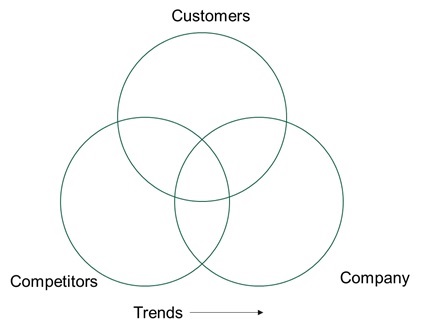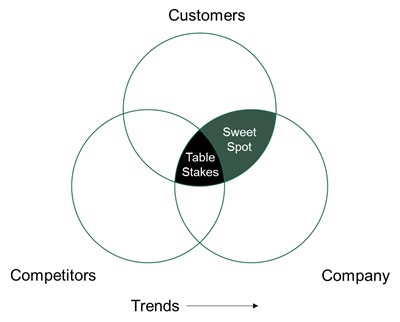Legendary management consultant and author Peter Drucker once said, “The aim of marketing is to know and understand the customer so well the product or service fits him and sells itself.”
Drucker is considered the founder of modern management and although I agree with his quote, reality can be a little more complex. Yes, it is critical to understand your customer. But it’s equally important to understand the other variables that affect your sales: your own business, your competitors, and future trends in your industry.
How can you figure out how all of these factors relate? Grow MFG uses a diagram called the “3C Needs Map” (see below). This tool shows you how your company’s and competitors’ offerings and your customers’ needs intersect.
Each circle on the map represents a group of needs. “Needs” could be anything from a particular product to something more abstract, like high-quality customer service or technical support. The Customer circle represents the needs that customers demand. The Competitors and Company circles, likewise, represent the needs suppliers have to offer. You’ll also notice the arrow representing “Trends.” This is to reinforce the fact that this chart is not static; it evolves constantly as innovations emerge and market forces shift.
The first thing this chart should make clear is that customer needs are not met equally. There are some needs you meet, that competitors don’t; others that competitors meet, that you don’t; and still others on which you compete head-to-head.
There are a few areas of the chart I’d like to draw your attention to. The first is the area in the very center of the chart, marked “table stakes.” You can think of this area as the minimum requirements you need to successfully sell in this market. These are needs that customers want, and you and your competitors both offer. In other words, these are factors on which you compete directly. This is an important area for all businesses, but not an area where a company can distinguish itself from the competition.
A second critical area is the one marked “sweet spot.” Your business’ “sweet spot” is your differentiators—the things you offer that customers want and no competitors can deliver.
Let’s say you’re a component manufacturer to the appliance industry. You and your competitors might compete head-to-head on quality and lead times. Your competitor might offer lower prices. What’s left for you? Upon close examination, you might discover that your ultra-responsive customer service sets you apart. Customers that value ultra-responsive customer service fall into the sweet spot and should be an area for you to target.
The important thing about differentiators—that many businesses overlook—is that they don’t do you any good unless your customers view them as such. Unless a customer sees a certain quality as a reason to choose you over your competition, it’s not truly in your sweet spot.
An important task for all businesses is to identify their own sweet spots, make customers aware of them—and then decide how to operate and possibly expand in those areas.
What else can the 3C Needs Map teach you? Learn more in our next post.



